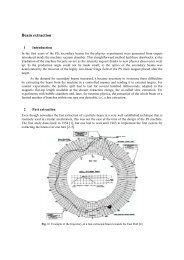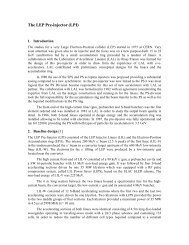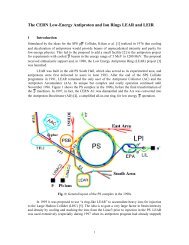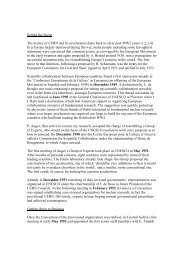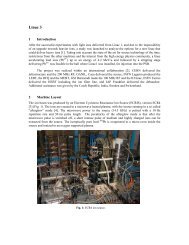RF gymnastics in the PS - CERN
RF gymnastics in the PS - CERN
RF gymnastics in the PS - CERN
Create successful ePaper yourself
Turn your PDF publications into a flip-book with our unique Google optimized e-Paper software.
Fig. 21: Multiple splitt<strong>in</strong>g scenario for <strong>the</strong> nom<strong>in</strong>al bunch distance of 25 ns for <strong>the</strong> LHCTriple splitt<strong>in</strong>g is started as soon as <strong>the</strong> second batch is received, which provides 18consecutive bunches on h=21. The beam is <strong>the</strong>n accelerated on this harmonic up to <strong>the</strong> 25 GeV flattop,where each bunch is twice split <strong>in</strong>to two to give 72 consecutive bunches on h=84. This leaves a320 ns gap <strong>in</strong> <strong>the</strong> bunch tra<strong>in</strong> for <strong>the</strong> rise-time of <strong>the</strong> ejection kicker.Triple splitt<strong>in</strong>g requires three simultaneous <strong>RF</strong> harmonics (h=7, h=14 and h=21) which can beprovided by <strong>the</strong> ferrite cavities divided <strong>in</strong> three different tun<strong>in</strong>g groups. The relative phases betweenharmonics are such that a stable phase on h=21 and an unstable phase on h=14 co<strong>in</strong>cide with <strong>the</strong>stable phase on h=7. Start<strong>in</strong>g with h=7 alone, <strong>the</strong> effect of <strong>in</strong>creas<strong>in</strong>g <strong>the</strong> voltages on h=14 and h=21is to flatten <strong>the</strong> bunch (t = 7 ms <strong>in</strong> Fig. 22). In phase space, two new stable po<strong>in</strong>ts emerge close to <strong>the</strong><strong>in</strong>itial one, encircled by three buckets. Us<strong>in</strong>g numerically determ<strong>in</strong>ed laws of variation, <strong>the</strong>se threeareas are kept equal throughout <strong>the</strong> process so that layers of <strong>in</strong>creas<strong>in</strong>g emittance <strong>in</strong> <strong>the</strong> <strong>in</strong>itial bunchare progressively peeled off and accumulated evenly <strong>in</strong>to <strong>the</strong> three new buckets. Provided that <strong>the</strong> rateof change of <strong>the</strong> voltages is sufficiently slow, <strong>the</strong> particles of <strong>the</strong> <strong>in</strong>itial bunch are gradually captured<strong>in</strong> <strong>the</strong> new buckets whose area grows as <strong>the</strong> voltage decreases on h=7 and <strong>in</strong>creases on h=21(t = 14 ms). Three equal bunches are f<strong>in</strong>ally obta<strong>in</strong>ed, each with <strong>the</strong> same distribution of particledensity as <strong>the</strong> <strong>in</strong>itial one (t = 25 ms). The low-level <strong>RF</strong> generates <strong>the</strong> different harmonics, preciselycontroll<strong>in</strong>g <strong>the</strong>ir relative phases. A beam phase loop is active throughout <strong>the</strong> process, controll<strong>in</strong>g <strong>the</strong>sum of all harmonics whose relative phase is rigidly fixed. A typical result at <strong>the</strong> nom<strong>in</strong>al <strong>in</strong>tensity for<strong>the</strong> LHC is shown <strong>in</strong> Fig. 23(a).Fig. 22: Pr<strong>in</strong>ciple of triple splitt<strong>in</strong>g12



